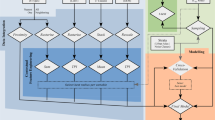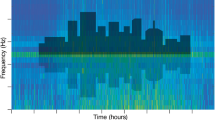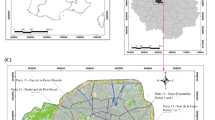Abstract
The availability of noise maps to assess exposure to noise is often limited, especially in North American cities. We developed land use regression (LUR) models for LAeq24h, Lnight, and Lden to assess the long-term spatial variability of environmental noise levels in Montreal, Canada, considering various transportation noise sources (road, rail, and air). To explore the effects of sampling duration, we compared our LAeq24h levels that were computed over at least five complete contiguous days of measurements to shorter sampling periods (20 min and 24 h). LUR models were built with General Additive Models using continuous 2-min noise measurements from 204 sites. Model performance (adjusted R2) was 0.68, 0.59, and 0.69 for LAeq24h, Lnight, and Lden, respectively. Main predictors of measured noise levels were road-traffic and vegetation variables. Twenty-minute non-rush hour measurements corresponded well with LAeq24h levels computed over 5 days at road-traffic sites (bias: −0.7 dB(A)), but not at rail (−2.1 dB(A)) nor at air (−2.2 dB(A)) sites. Our study provides important insights into the spatial variation of environmental noise levels in a Canadian city. To assess long-term noise levels, sampling strategies should be stratified by noise sources and preferably should include 1 week of measurements at locations exposed to rail and aircraft noise.
This is a preview of subscription content, access via your institution
Access options
Subscribe to this journal
Receive 6 print issues and online access
$259.00 per year
only $43.17 per issue
Buy this article
- Purchase on Springer Link
- Instant access to full article PDF
Prices may be subject to local taxes which are calculated during checkout


Similar content being viewed by others
References
Basner M, Babisch W, Davis A, Brink M, Clark C, Janssen S et al. Auditory and non-auditory effects of noise on health. Lancet 2014; 383: 1325–1332.
World Health Organization Guidelines for Community Noise. World Health Organization: Geneva, Switzerland. 1999.
Steele C . A critical review of some traffic noise prediction models. Appl Acoust 2001; 62: 271–287.
Lui WK, Li KM, Ng PL, Frommer GH . A comparative study of different numerical models for predicting train noise in high-rise cities. Applied Acoustics 2006; 67: 432–449.
European Commission. Directive 2002/49/EC of the European Parliament and of the Council of 25 June 2001 relating to the assessment and management of environmental noise. Off J Eur Commun 2002; L 189/12: 12–25.
Hystad P, Davies HW, Frank L, Van Loon J, Gehring U, Tamburic L et al. Residential greenness and birth outcomes: evaluating the influence of spatially correlated built-environment factors. Environ Health Perspect 2014; 122: 1095–1102.
Vienneau D, Schindler C, Perez L, Probst-Hensch N, Röösli M . The relationship between transportation noise exposure and ischemic heart disease: a meta-analysis. Environ Res 2015; 138: 372–380.
Aguilera I, Foraster M, Basagañ a X, Corradi E, Deltell A, Morelli X et al. Application of land use regression modelling to assess the spatial distribution of road traffic noise in three European cities. J Expo Sci Environ Epidemiol 2015; 25: 97–105.
Xie D, Liu Y, Chen J . Mapping urban environmental noise: a land use regression method. Environ Sci Technol 2011; 45: 7358–7364.
Goudreau S, Plante C, Fournier M, Brand A, Roche Y, Smargiassi A . Estimation of spatial variations in urban noise levels with a land use regression model. Environ Pollut 2014; 3: 48–58.
Hoek G, Beelen R, de Hoogh K, Vienneau D, Gulliver J, Fischer P et al. A review of land-use regression models to assess spatial variation of outdoor air pollution. Atmos Environ 2008; 42: 7561–7578.
Can A, Dekoninck L, Botteldooren D . Measurement network for urban noise assessment: Comparison of mobile measurements and spatial interpolation approaches. Appl Acoust 2014; 83: 32–39.
Stoter J, De Kluijver H, Kurakula V . 3D noise mapping in urban areas. Int J Geogr Inf Sci 2008; 22: 907–924.
Lee EY, Jerrett M, Ross Z, Coogan PF, Seto EYW . Assessment of traffic-related noise in three cities in the United States. Environ Res 2014; 132: 182–189.
Zuo F, Li Y, Johnson S, Johnson J, Varughese S, Copes R et al. Temporal and spatial variability of traffic-related noise in the City of Toronto, Canada. Sci Total Environ 2014; 472: 1100–1107.
Morelli X, Foraster M, Aguilera I, Basagana X, Corradi E, Deltell et al. Short-term associations between traffic-related noise, particle number and traffic flow in three European cities. Atmos Environ 2015; 103: 25–33.
Allen RW, Davies H, Cohen MA, Mallach G, Kaufman JD, Adar SD . The spatial relationship between traffic-generated air pollution and noise in 2 US cities. Environ Res 2009; 109: 334–342.
Davies HW, Vlaanderen JJ, Henderson SB, Brauer M . Correlation between co-exposures to noise and air pollution from traffic sources. Occup Environ Med 2009; 66: 347–350.
Gan WQ, McLean K, Brauer M, Chiarello SA, Davies HW . Modeling population exposure to community noise and air pollution in a large metropolitan area. Environ Res 2012; 116: 11–16.
Statistics Canada. Population and dwelling counts, for Canada and economic regions, 2011 and 2006 censuses, 2012. Available at https://www12.statcan.gc.ca/census-recensement/2011/dp-pd/hlt-fst/pd-pl/Table-Tableau.cfm?LANG=Eng&T=1402&PR=24&S=51&O=A&RPP=25. Accessed September 2012.
Kanaroglou PS, Jerrett M, Morrison J, Beckerman B, Arain MA, Gilbert NL et al. Establishing an air pollution monitoring network for intra-urban population exposure assessment: a location-allocation approach. Atmos Environ 2005; 39: 2399–2409.
Transport Canada. Noise Exposure Forecast and Related Programs, 2012. Available from https://www.tc.gc.ca/eng/civilaviation/standards/aerodromeairnav-standards-noise-nef-924.htm. Accessed 10 March 2015.
Bodin T, Björk J, Öhrström E, Ardö J, Albin M . Survey context and question wording affects self reported annoyance due to road traffic noise: a comparison between two cross-sectional studies. Environ Health 2012; 11: 14.
Foraster M, Deltell A, Basagañ a X, Medina-Ramon M, Aguilera I, Bouso L et al. Local determinants of road traffic noise levels versus determinants of air pollution levels in a Mediterranean city. Environ Res 2011; 111: 177–183.
Agence métropolitaine de transport (AMT). Enquête origine-destination 2008. La mobilité des personnes dans la région de Montréal. Agence métropolitaine de transport (AMT), Ministère des Transports du Québec, les sociétés de transport de la RMR de Montréal et l’École Polytechnique: Montreal, 2008.
Sider T, Alam A, Zukari M, Dugum H, Goldstein N, Eluru N et al. Land-use and socio-economics as determinants of traffic emissions and individual exposure to air pollution. J Transp Geogr 2013; 33: 230–239.
Weier J, Herring D, Measuring Vegetation (NDVI & EVI), 2000. Available from http://earthobservatory.nasa.gov/Features/MeasuringVegetation. Accessed 20 September 2015.
Hastie TJ, Tibshirani RJ . Generalized Additive Models. CRC Press: London 1990.
Grömping U . Relative importance for linear regression in R: the package relaimpo. J Stat Softw 2006; 17: 1–27.
Pathak V, Tripathi BD, Mishra VK . Dynamics of traffic noise in a tropical city Varanasi and its abatement through vegetation. Environ Monit Assess 2008; 146: 67–75.
Ayres-Sampaio D, Teodoro AC, Sillero N, Santos C, Fonseca J, Freitas A . An investigation of the environmental determinants of asthma hospitalizations: an applied spatial approach. Appl Geogr 2014; 47: 10–19.
Ganguly R, Batterman S, Isakov V, Snyder M, Breen M, Brakefield-Caldwell W . Effect of geocoding errors on traffic-related air pollutant exposure and concentration estimates. J Expo Sci Environ Epidemiol 2015; 25: 490–498.
Acknowledgements
This project was funded by the Montreal Public Health Department and by the Quebec Institute of Public Health. We thank Louis Drouin for his valuable logistic support and Allan Brand for his help in preparing the NDVI and meteorological data.
Author information
Authors and Affiliations
Corresponding author
Ethics declarations
Competing interests
The authors declare no conflict of interest.
Additional information
Supplementary Information accompanies the paper on the Journal of Exposure Science and Environmental Epidemiology website
Supplementary information
Rights and permissions
About this article
Cite this article
Ragettli, M., Goudreau, S., Plante, C. et al. Statistical modeling of the spatial variability of environmental noise levels in Montreal, Canada, using noise measurements and land use characteristics. J Expo Sci Environ Epidemiol 26, 597–605 (2016). https://doi.org/10.1038/jes.2015.82
Received:
Revised:
Accepted:
Published:
Issue Date:
DOI: https://doi.org/10.1038/jes.2015.82
Keywords
This article is cited by
-
Long-term measurement study of urban environmental low frequency noise
Journal of Exposure Science & Environmental Epidemiology (2023)
-
Predicting traffic noise using land-use regression—a scalable approach
Journal of Exposure Science & Environmental Epidemiology (2022)
-
Temporal variability of noise pollution attenuation by vegetation in urban parks
Environmental Science and Pollution Research (2021)
-
Vehicular traffic noise prediction and propagation modelling using neural networks and geospatial information system
Environmental Monitoring and Assessment (2019)
-
The Canadian Urban Environmental Health Research Consortium – a protocol for building a national environmental exposure data platform for integrated analyses of urban form and health
BMC Public Health (2018)



